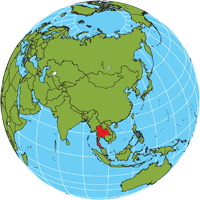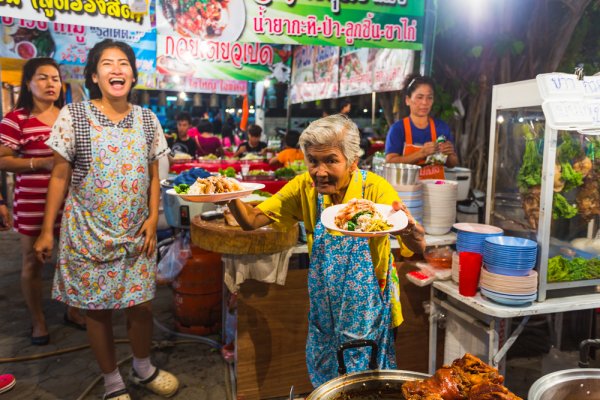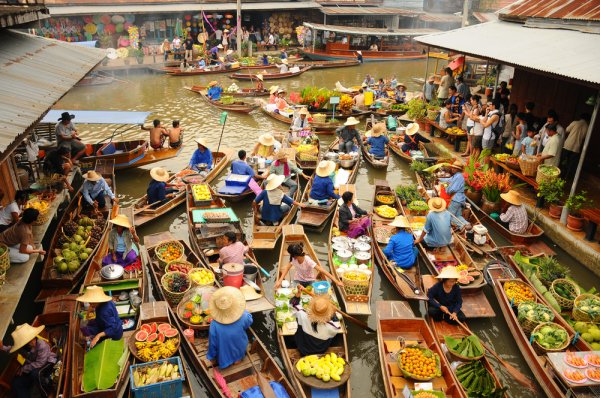Food and Drink: National Cuisine
Thai cuisine has a complexity that defies its simple preparation. Fresh and light, minimal cooking keeps ingredients healthy, with aromatic and spicy seasoning defining most dishes. Thai food has layers of flavor that include sweet, spicy, salty, and sour, with all four represented in a common Thai meal.
Much of traditional Thai cuisine will generally fall into one of four categories: yam (spicy salads), tam (pounded foods), tom (boiled dishes), or gaeng (curries). Deep-fries, stir-fries, and steamed dishes originate in Chinese cuisine. India and Persia lent deep-frying and stir-frying methods, along with several types of noodles and tofu.
Basic Ingredients
In most Thai dishes, meat or seafood is combined with local vegetables, herbs, and spices and served with rice. The stars of most dishes are citrusy or aromatic herbs such as lemongrass and lime leaves, ginger, galangal, garlic, basil, cilantro (coriander), thyme, and oregano. Vinegar notes and chiles also lend a flavorful zing to Thai cuisine. Fish and seafood are indispensable ingredients, while savory sauces and pastes are widely used including soy and fish sauces as well as chili, bean, and shrimp pastes. Prominent vegetables used in Thai dishes include eggplant, cucumbers, tomatoes, bean sprouts, kale, sweet potato, and edible flowers, as well as beans, squash, corn, and several types of mushrooms. An array of fresh, tropical fruit includes durian, jackfruit, pineapple, bananas, and custard apples, which are eaten as snacks and desserts. Pomelo, papaya, coconut, and mango are enjoyed as well, with the most popular Thai dessert being mango with sticky rice.
Essential Rice
Rice is omnipresent in the country’s food and is not only widely grown but is a significant contributor to the country’s economy. There are many popular rice dishes such as khao chao (steamed, non-glutinous white rice), khao hom mali (long grain jasmine rice), and khao niao (white sticky rice). Black sticky rice and Thai red cargo rice add color and interest. Rice, pounded into flour, acts as a thickening agent and transforms into rice noodles. Indeed, noodles are a popular feature of Thai cuisine, and likely the most popular dish is pad thai, one of the country’s national dishes made with fried noodles, bean curd, and vegetables.
Five Elements, Five Flavors
A belief linking certain ingredients with medicinal benefits influences the Thai approach to meals and cooking methods. Five elements and their corresponding flavors are key to understanding how the food is prepared with an emphasis on balance. Wood represents sourness, while fire symbolizes a bitter flavor. Sweetness is associated with earth, while metal conjures spiciness, and water represents a salty flavor. These qualities lend insight to the country’s unique cuisine, the essential elements of which date back centuries.
Cuisines vary regionally, with the northern, northeastern, central, and Bangkok regions offering up select recipes. In the southern region of the country Thai food is especially spicy. Some recipes are common to Thailand’s neighboring countries—Laos, China, Burma, Cambodia and Vietnam—though have different names. Malay, Indian, and Indonesian influences also are present in Thai food through coconut milk and turmeric. All these countries have mixed their cultures over centuries to make Thai cuisine what it is today.
Copyright © 1993—2025 World Trade Press. All rights reserved.

 Thailand
Thailand 

